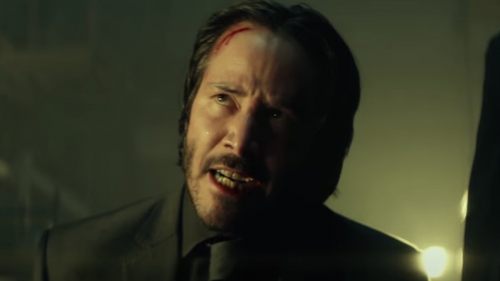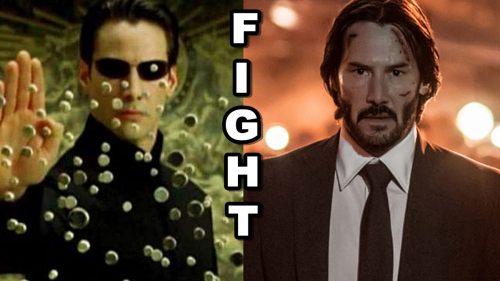The World Of JOHN WICK
Jean-Pierre Melville said, “a film is first and foremost a dream.” Chad Stahelski’s and David Leitch’s John Wick is a dream of grief and retribution, of a hyperreal world hidden from our view, of a character both mythic and human. John Wick is, at its most fundamental, a fable about dealing with grief. John is a widower mourning the loss of his wife Helen, whose death feels like punishment enough for the sins of his past. But the theft of his 1969 Mustang and the killing of his new puppy Daisy, a final gift from Helen, drive John Wick’s descent into a world where he was once a hitman. Although John Wick already feels like a cult classic, some still reduce it to “another revenge movie,” and its singular world remains overlooked. John Wick’s universe is one where killers abide by a code of honor, share unspoken connections and hint at mysterious pasts, where violence is not only sanctioned but the only righteous course of action.
John is just a man when John Wick begins: eating cereal, wearing pajamas, coping with an empty home after his wife’s death. And then he crosses paths with Russian mobster Iosef Tarasov (Alfie Allen) and his friends, who beat John with a baseball bat, kill Daisy, and steal his car. As John scrubs the dog’s blood off the floor the next morning, his expression shifts. He becomes a force of nature, unstoppable, and an underworld he’d left behind draws him back in.
John checks into the Continental Hotel, a sanctuary for assassins with strict rules, and anyone who breaks them “incurs heavy penalties.” Every patron in the lobby is dressed in shades of black, and the hotel’s interior feels timeless, both modern and Art Deco, a liminal space. The Continental’s unflappable concierge Charon (Lance Reddick) says, with the ghost of a smile, that it’s a pleasure having him with them again. There is a sense of deep respect, even affection for John Wick — and excitement that he may return to the fold.
The assassins of John Wick are sophisticated, sensible, polite. Everyone dresses impeccably. They can relax at a secret speakeasy in the underbelly of the Continental. To pay for accommodation at the hotel, they use gold coins, which are like credit cards, a membership card, I.D., and currency all in one — a coin gains entry into the speakeasy, medical care, body disposal, and more. They evoke Charon’s obol of Greek myth, the coin placed in or on the mouth of a body before burial, payment for Charon the ferryman who conveys the dead across the Styx into Hades. On one side of the assassins’ coin is the image of a woman who represents both peace and violence and reads EX UNITAE VIRES or “unity is strength”; on the other side, a lion and a shield for protection, which reads ENS CAUSA SUI — “a being that causes itself,” who owes existence to no other being, like god.
The evolving color palette of John Wick is expressionistic, denoting the assassins’ domain and reflecting moods. John’s memories of his wife Helen and time spent with Daisy are warm shades of yellow, his scenes without them exist in a gray and rain-slicked-black limbo. Then John enters a world illuminated by “all the colors of the dark.” It’s the palette of Mario Bava, of Dario Argento, used in Suspiria to create the feeling of a nightmare and to warn of the danger of dark forces. Pulsing red light heralds John Wick’s entrance into the Red Circle’s blue womb-like bathhouse where Iosef waits as bait, and it illuminates his expression of desirous rage, a fluorescent-red circle haloing him. Feverish green flashes during John’s pursuit through the nightclub, and a hypnotic spiral frames him like an apparition or a hallucination as he hunts Iosef through a hell of his own making.
John Wick blends Biblical vengeance and the underworld of ancient Greek mythology with the modern feel of a graphic novel to create a unique universe. The punishment for a crime like killing John Wick’s dog is more than “an eye for an eye,” more than “avenged sevenfold,” it’s “avenged seventy and sevenfold.” And themes of Greek drama and myth define John Wick: the ineluctability of fate, the price of hubris, the way bloodshed begets bloodshed. John Wick isn’t exactly the Boogeyman, “he was the one you sent to kill the fucking Boogeyman” — he never offed someone who didn’t have it coming. During his pursuit of Iosef, he refuses to harm an innocent, even when Iosef uses a woman as a shield. Wick is more like Nemesis, goddess of righteous vengeance, who swiftly metes out divine retribution. She punishes hubris and injustice, a transgression of the natural order.
Nemesis was referred to as “inescapable one,” and John Wick is just as formidable. Like Rasputin, he survives countless attempts to kill him — he’s beaten with a baseball bat, stabbed with a broken bottle, thrown off a balcony, shot, suffocated, hit by an S.U.V., pummeled. Keanu Reeves trained for four months so he could do most of his own stunts: eight hours a day, five days a week of gun training, driving training, martial arts training. And we have Reeves to thank for John Wick’s insane body count: in early drafts of the screenplay, about twelve people died, but Reeves’s response to each new draft was, “he could still kill more.”
Revenge movies tend to be right-wing wet dreams, fascist power fantasies. The avenging protagonist is often cold and calculating, or single-minded in their furious rampage. But it’s grief that drives John Wick as much as his anger. John Wick has more in common with Kill Bill or The Man from Nowhere, films where the intensity of its violence reflects intensity of emotion, and John Wick emotes with every stab, punch, and gunshot. John Wick is not a lone wolf — he did not choose solitude, it was chosen for him.
During filming of John Wick, Keanu Reeves insisted on imbuing the character with vulnerability. John weeps over Helen’s letter, slouches alone in his hotel room as he watches a video of her on his phone. There is tenderness in the way he touches Daisy when he sees her the morning after Iosef’s break-in, the way he piled up new dog supplies and toys in his Mustang’s backseat. He keeps Helen’s silver daisy bracelet next to his watch on the nightstand, and after Daisy’s death, he places her collar there, too. His black suit, which announces the change from just John to John Wick, is funerary — his fury may fuel him, but he’s mourning. He moves as if shell-shocked. He carries his grief with him.
John Wick kills nearly eighty people over what Iosef and those protecting him consider “just a fucking dog.” But a dog is never just a dog — it’s a sacred, selfless thing, the ultimate innocent, who trusts you to protect it, and who loves you more than it loves itself. The way we treat dogs reflects who we are. In The Unbearable Lightness of Being, Milan Kundera wrote: “True human goodness . . . can come to the fore only when its recipient has no power. Mankind’s true moral test, its fundamental test . . . consists in its attitude towards those who are at its mercy: animals.” John Wick comes to love Daisy, but Iosef kills her without a second thought. He fails the assassins’ — and our — moral test. To John, Daisy represented hope, his humanity. At the end of John Wick, John finds redemptive closure and shows he’s the hero of his world when he rescues a pitbull puppy marked to be put down, and reassures it, “It’s okay. Let’s go home.”



